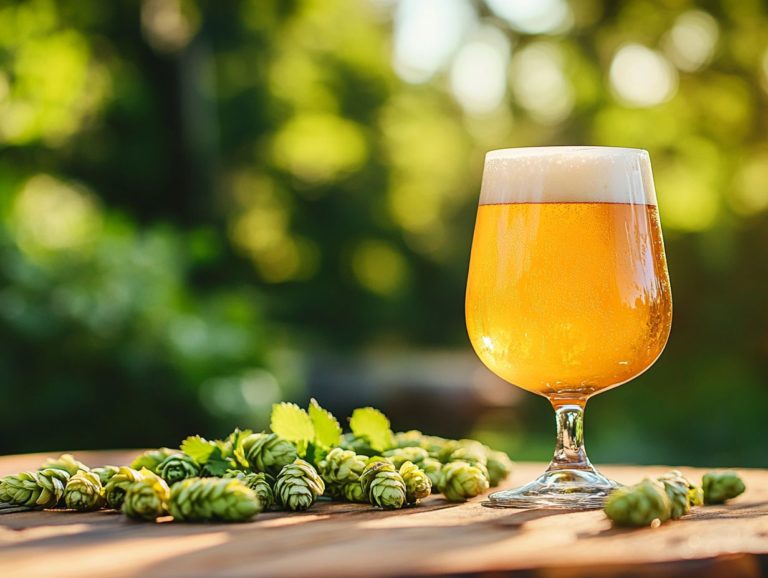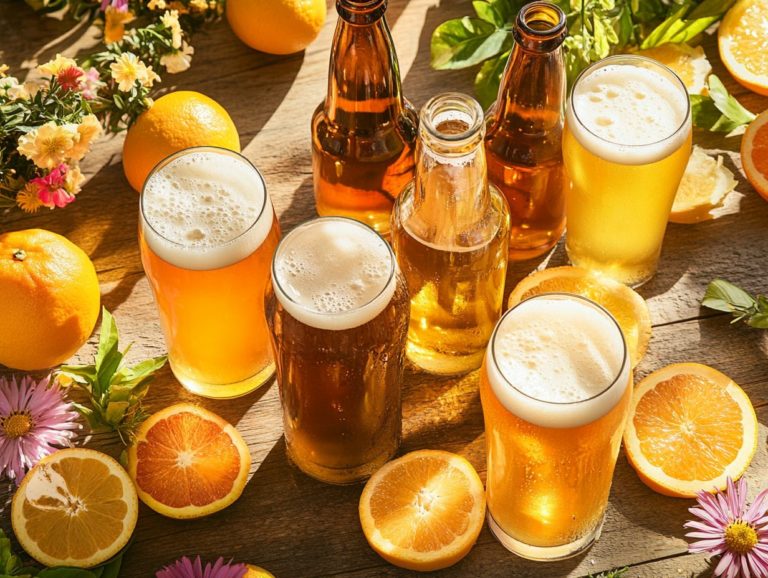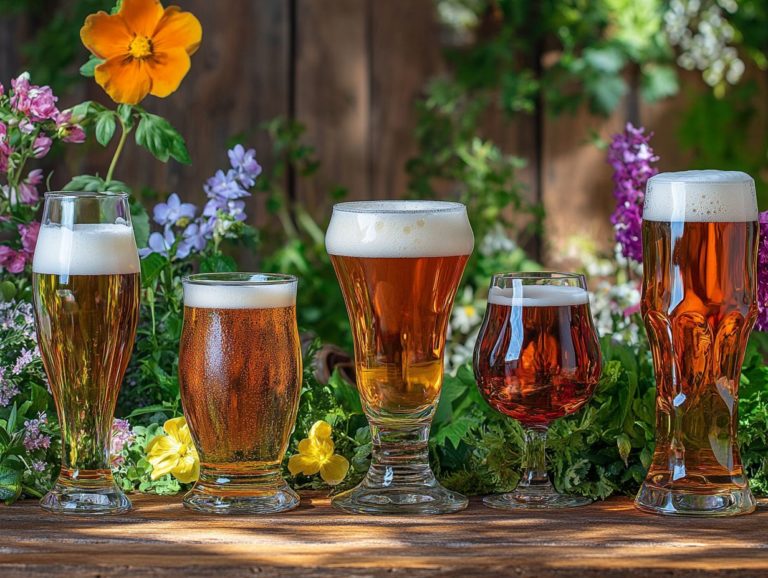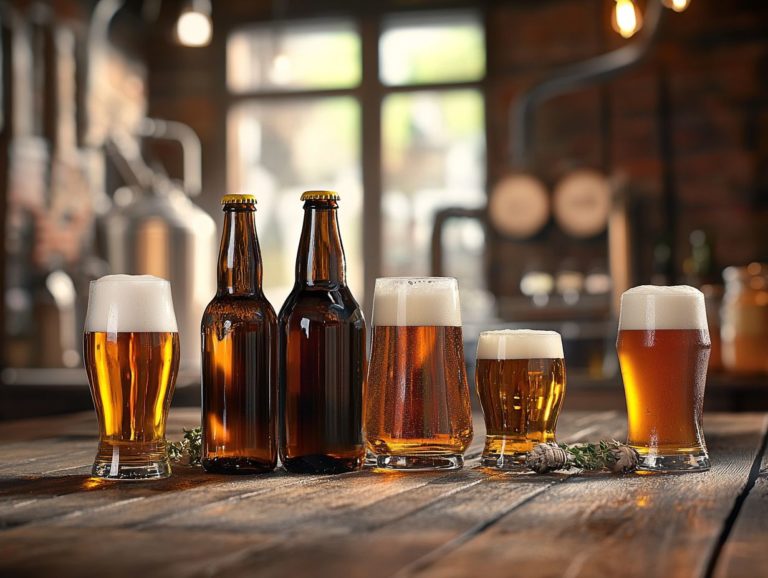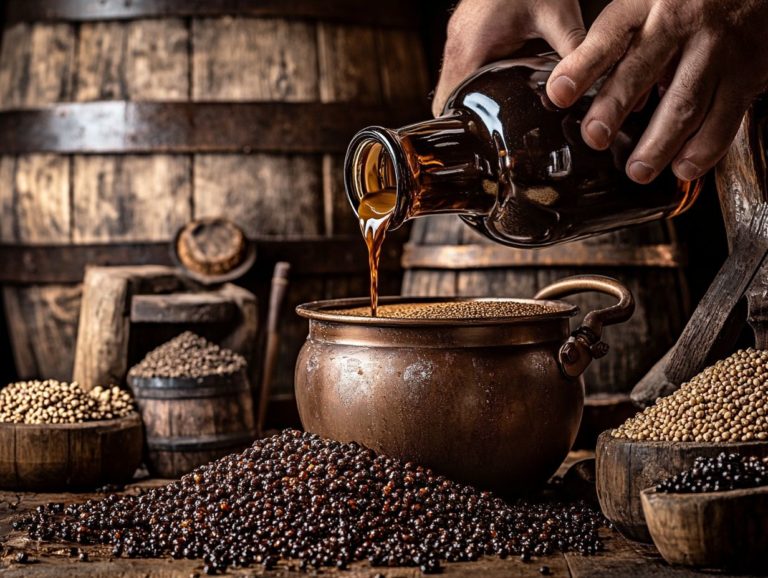The Rich History of Stout Beers Explained
Contents
- The Rich History of Stout Beer
- Key Takeaways:
- The Origins of Stout Beer
- The Different Types of Stout Beer
- The Popularity of Stout Beer Today
- 1. The Craft Beer Revolution
- 2. The Rise of Microbreweries
- 3. The Growing Demand for Unique Flavors
- The Health Benefits of Stout Beer
- 1. Nutritional Value
- 2. Antioxidant Properties
- 3. Heart Health Benefits
- 4. Bone Health Benefits
- Frequently Asked Questions
The Rich History of Stout Beer
Stout beer, with its deep flavors and rich history, has captivated beer lovers and enthusiasts like you for centuries.
Emerging from the rise of porter beer in the 18th century, stout has undergone a remarkable transformation, shaped by innovative Irish brewers who infused their unique twists into the mix.
Dive into the diverse world of stout, exploring everything from dry and sweet variations to the robust Russian Imperial stouts. Witness how their popularity has soared in today s craft beer renaissance. You will also discover the evolution of beer styles and how stouts have become a cornerstone in the taproom ecosystem.
Uncover the surprising health benefits that come with savoring this beloved brew don’t miss out on the antioxidants and its ability to promote heart and bone health.
Start your exciting journey through the fascinating realm of stout beer! Join us on this thrilling journey through beer history! From London porters to American stouts, every sip is a step through beer history.
Key Takeaways:
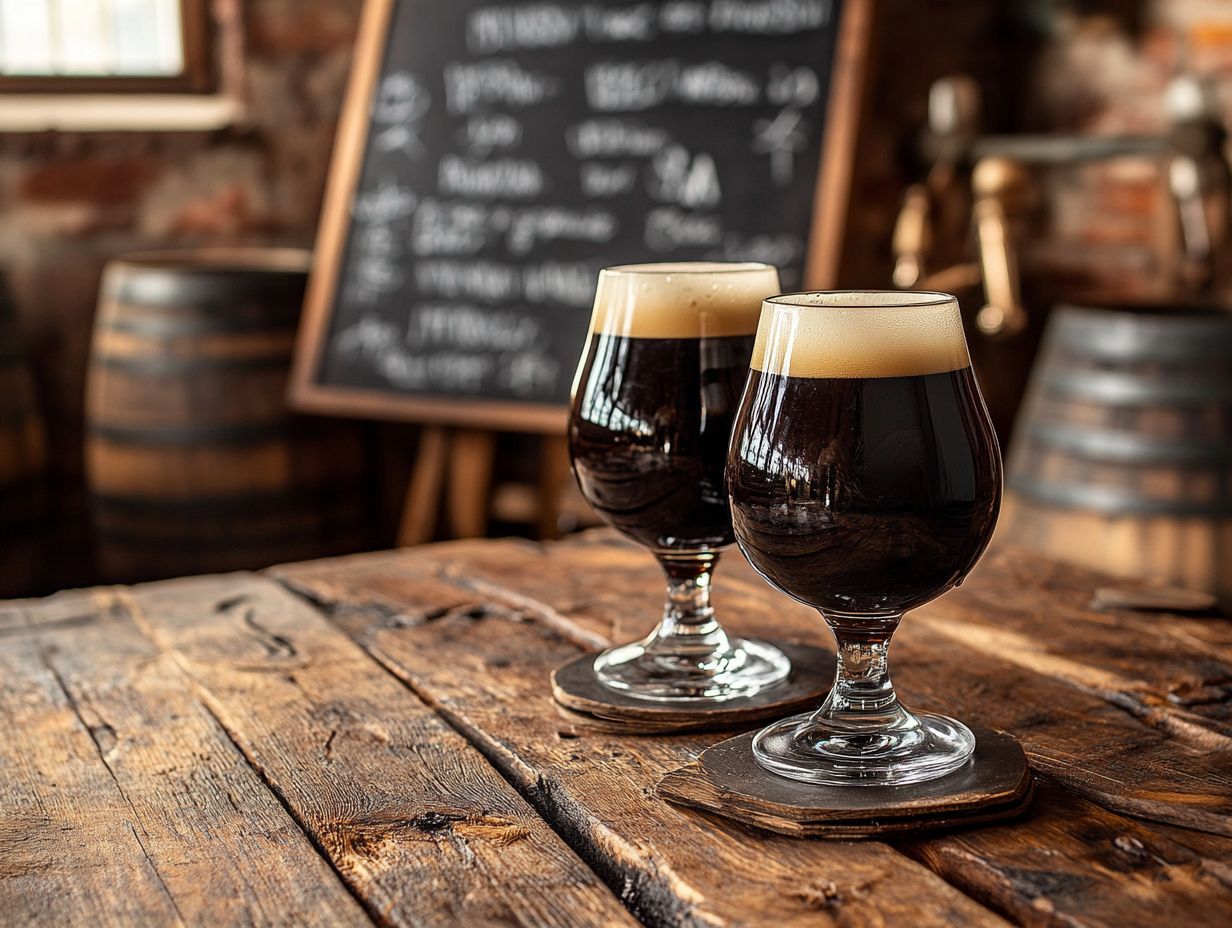
- Stout beer originated from the evolution of porter beer in the 18th century and was greatly influenced by Irish brewers.
- There are various types of stout beer such as dry, sweet, foreign extra, milk, oatmeal, and Russian imperial, each with their unique flavors and characteristics.
- The popularity of stout beer has grown in recent years due to the craft beer revolution, the rise of microbreweries, and the demand for unique flavors. It also offers health benefits such as antioxidants and promoting heart and bone health.
The Origins of Stout Beer
The origins of stout beer can be traced back to the illustrious brewing history of England, where the fascinating evolution from porter to stout took root in the 18th century. As brewers pushed the boundaries of their craft, experimenting with different techniques and ingredients, they sought to create stronger ales that would appeal to an increasingly sophisticated beer culture.
Today, places like Portland, Oregon have wholeheartedly embraced this rich heritage, fostering a vibrant craft brewing scene that not only honors the historical evolution of beer styles but also showcases beloved creations like the Baltic porter a type of stout that originated in the Baltic region Anchor Steam, and the inventive American stout.
1. The Rise of Porter Beer and Its Evolution
The rise of porter beer in the 18th century represents an important time in England’s brewing history, particularly within the vibrant scene of London. It quickly became the go-to choice for the working class, celebrated for its robust flavor and affordability.
This popularity led to a rich diversity of beer styles, such as London porters, that still influence modern craft brewing. This rich, dark beer, with its roasted malt flavors and subtle hints of chocolate, was born from innovative brewing techniques that would lay the groundwork for future styles, including the famed stout.
You can think of porter as a transitional bridge, linking the simpler ales of yesteryear to the more complex flavors found in later brews. Its inception can be traced back to a time when publicans recognized the burgeoning demand for a hearty beverage that could nourish workers after long, arduous days.
But the significance of porter extends far beyond mere refreshment; it cultivated a social atmosphere in taverns that served as vital community hubs in the industrial heart of London. Its legacy persists as modern brewers experiment with an array of ingredients and techniques, reinterpreting this classic style for a new generation.
The Evolution of Porter into Stout
The evolution of porter into stout is a captivating journey, one that showcases the brilliance of brewing innovations. As you delve into this transformation, you’ll discover how brewers began to experiment with fermentation processes (the method of converting sugars into alcohol) and new ingredients like bourbon barrels, giving rise to stouts a bolder, more intense variant of porters. These stouts, such as the strong lager and porter variations, are characterized by their deep colors and rich, robust flavors, which have enchanted beer enthusiasts throughout Europe and beyond.
This remarkable transformation was influenced by advancements in malt roasting techniques and the addition of innovative hops. Brewers influenced this transformation with advancements in malt roasting techniques. These developments not only enhanced the aromatic qualities but also crafted a unique character in each brew. Take roasted barley, for example; it not only darkens the beer s hue but also introduces a complex flavor profile with delightful notes of chocolate and coffee, setting stouts distinctly apart from their smoother, caramel-infused porter cousins.
The use of bourbon barrel aging has also brought new dimensions to flavor profiles, adding smoky flavor and depth. Historically, brewers experimented with various yeast strains and fermentation temperatures, further enriching the flavor spectrum. As the craft beer movement gained momentum, these myriad variations opened the door to niche styles and artisanal approaches, ultimately expanding consumer preferences and enriching the global beer community. This period saw significant figures like Michael Jackson promoting beer appreciation through his writings, further fueling the brewery revival.
The Influence of Irish Brewers
Irish brewers have undeniably shaped the modern stout, with Guinness leading the charge. They introduced a creamy milk stout that quickly became a cornerstone of pub culture, showcasing intricate brewing traditions that emphasize flavor and quality within the beer community.
The legacy of Irish stout goes far beyond a single brand; it weaves a rich tapestry of innovation and craftsmanship that has left a lasting mark on global beer culture. Iconic brewing methods, such as the use of roasted barley and distinctive fermentation techniques, have established a benchmark for brewing excellence. Modern breweries, like Hammer & Stitch, continue to honor these time-tested traditions while also introducing new and innovative brewing ingredients.
The deep, rich flavors found in stouts stand in stark contrast to lighter ales, inviting both connoisseurs and casual drinkers to embark on a journey through new dimensions of taste. Be it the rich, creamy texture of milk stout or the bold intensity of imperial stout (known for its higher alcohol content and bold flavors), there’s something for everyone.
These practices have not only defined the identity of stouts but have also inspired breweries around the world to experiment with similar styles, enriching the diversity of beers available today. Breweries like Goose Island and Booker Noe have notably contributed to this robust diversity with their unique interpretations and innovations.
The Different Types of Stout Beer
Grasping the various types of stout beer is crucial for any beer enthusiast. Each style presents its own distinct characteristics, from the robust flavors of dry stout to the delightful sweetness of oatmeal stout. Whether it’s the smoky flavor of a traditional Irish stout or the innovative twists found in chocolate stouts, the variety is endless.
These variations not only showcase diverse brewing techniques but also celebrate the rich traditions behind craft brewing, inviting everyone to explore!
1. Dry Stout
Dry stout features a rich, dark color and roasted malt flavors. It offers a unique drinking experience with low sweetness and balanced bitterness.
This style has garnered a loyal following among beer aficionados who appreciate its robust flavor and moderate alcohol content, often found in iconic brands like Guinness and Samuel Smiths.
You ll often find that dry stouts typically feature an alcohol content ranging from 4% to 6%, appealing to those who seek a rich yet tempered drinking adventure. The brewing process is interesting; it involves using roasted barley, which not only gives the beer its deep, dark hue but also contributes to its complex flavor profile.
Hops play their part too, adding subtle bitterness that perfectly counters the malt s sweetness.
Rooted in Irish brewing traditions, dry stout has crossed oceans and inspired countless craft brewers to add their own twist to the classic recipe. You might encounter notable examples like Foreign Extra Stout, celebrated for its bold character, or American variations that introduce unique elements while still respecting the original style.
2. Sweet Stout
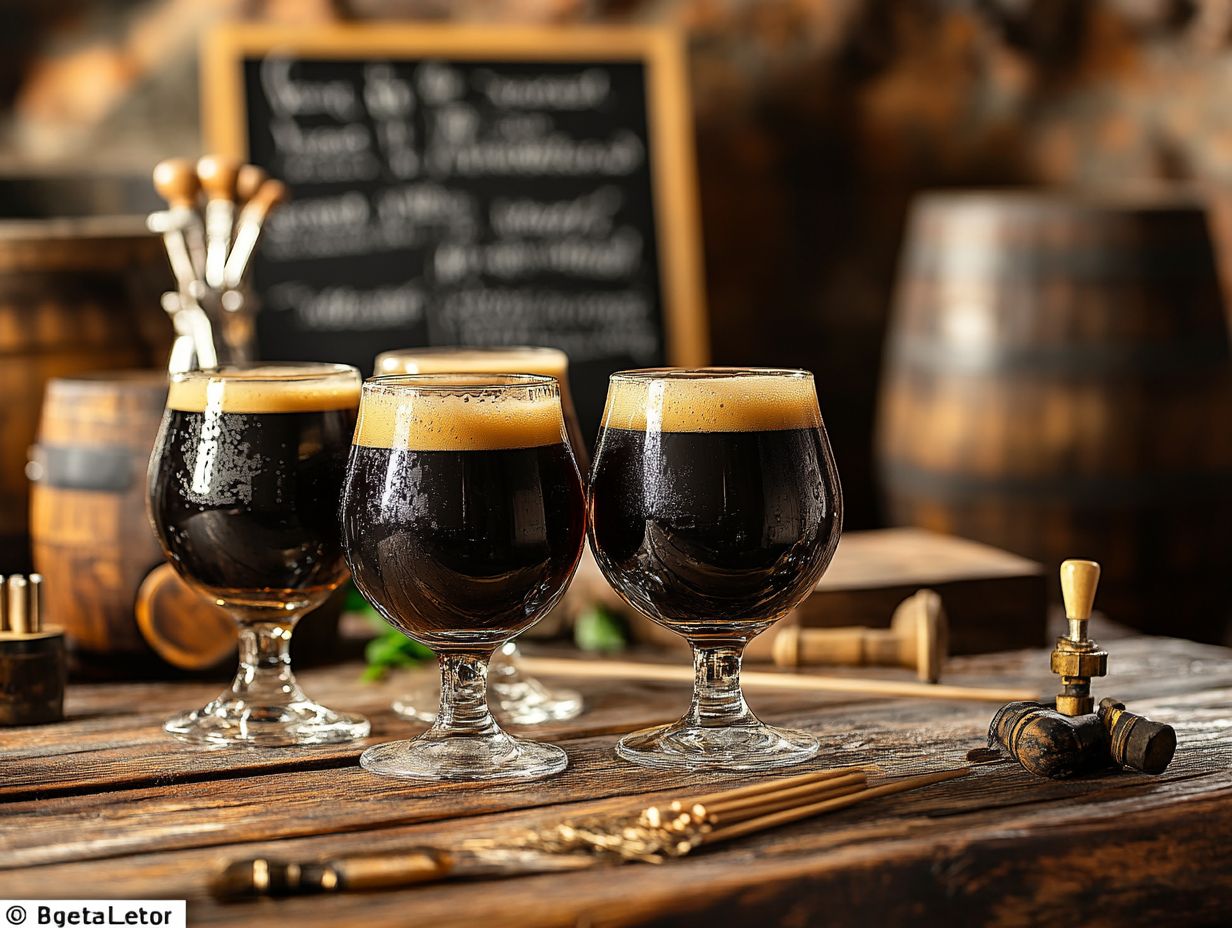
Sweet stout, often affectionately called milk stout due to the inclusion of lactose, is celebrated for its creamy, smooth texture and delightful sweetness. This style is perfect for those who relish a rich, indulgent drinking experience that showcases the versatility of stouts.
The inclusion of cold-pressed coffee in some variations further enhances the rich, smooth texture.
What makes sweet stout truly unique is its distinct brewing process, which sets it apart from its drier cousins. This method enhances the flavor profile with enchanting notes of chocolate, coffee, and caramel that elegantly dance across your palate.
Brewers skillfully balance the maltiness with the sweetness of lactose, crafting a harmonious interplay that is both refreshing and deeply satisfying. Some brewers even take it a step further by aging their sweet stouts in bourbon barrels, adding layers of complexity to the final brew.
The grain bill typically features roasted barley and chocolate malts, contributing to the beer’s dark hue and enriching its overall taste. As part of the broader stout family, milk stout offers an accessible introduction for those venturing into the world of craft beers, while also providing seasoned aficionados with a delightful twist on traditional stout recipes.
3. Foreign Extra Stout
Foreign extra stout is a robust and high-alcohol beer style that originated when British brewers began exporting their stouts to warm climates such as Poland and other regions. This adventurous decision resulted in a beer with a strong flavor and a higher alcohol content, ideal for anyone thirsting for a bold taste adventure!
This innovative approach gives rise to a stout distinguished by its dark, rich color and complex flavor profile. Typically brewed with a blend of roasted malts and barley, you can expect a delightful medley of chocolate, coffee, and caramel notes that beautifully complement its higher ABV, usually ranging from 7% to 10%.
The brewing techniques often include additional hops, which provide a balanced bitterness against the sweetness, further enriching the beer’s depth. This beer style has also influenced the production of strong lager and dark ales, adding more variety to the beer market.
The cultural significance of foreign extra stout thrives in regions like Africa and parts of the Caribbean, where it has found a warm and welcoming audience. Here, enthusiasts celebrate both its heritage and unique flavor, a combination that continues to captivate beer lovers around the globe, much like the early days of London porters and Irish stout in beer history.
4. Milk Stout
Milk stout, a delightful variant of sweet stout, features the addition of lactose, which lends a creamy texture and sweet flavor that many have come to adore for its dessert-like qualities in the world of beer. This type of stout, much like the traditional Guinness or modern pastry stout, offers a rich experience for beer enthusiasts.
This sugar, sourced from milk, isn t fermentable by yeast, allowing it to create a velvety mouthfeel while balancing the roasted and slightly bitter notes that are characteristic of stouts. The malt bill typically showcases a harmonious blend of roasted barley, caramel malts, and chocolate malt, enriching the flavor profile with depth and complexity reminiscent of a chocolate stout.
As a result, milk stout presents a multi-layered tasting experience, which undoubtedly enhances its allure among craft beer aficionados. You might also encounter varieties infused with adjuncts like vanilla or coffee, further accentuating its dessert-like essence and solidifying its status as a favored choice for those in search of a sweeter, more indulgent beverage.
5. Oatmeal Stout
Oatmeal stout is a delightful style that invites you to experience the brewing magic of oats, resulting in a smooth mouthfeel and a rich, creamy head. It has become a sought-after choice for beer enthusiasts who appreciate a more nuanced flavor profile.
The addition of oats not only lends a velvety texture but also elevates the beer’s overall complexity. You ll discover subtle notes of chocolate and coffee that beautifully complement the roasted malt foundation. This unique characteristic sets oatmeal stout apart from other stout varieties, appealing to a diverse audience of craft beer lovers like yourself who seek depth in their brews.
Brewing techniques such as incorporating flaked oats or oat malt play a crucial role in achieving this balance. They provide a silky body that contrasts with the more intense bitterness found in traditional stouts. The result is a smooth and fulfilling drinking experience that encourages you to explore the rich tapestry of stout styles.
6. Russian Imperial Stout
Russian imperial stout is a bold and complex beer style that you ll come to appreciate for its high alcohol content and rich flavors. Often aged in bourbon barrels, this method enhances its complexity, showcasing the craftsmanship and dedication of brewers who strive to create exceptional strong lagers, much like the historical beer evolution during the bourbon revolution.
This unique brewing tradition dates back to the 18th century when it was a favorite among Russian royalty. It artfully combines dark malts with a variety of hops, striking a delightful balance between s sweetness and bitterness that tantalizes your palate. The aging process in bourbon barrels doesn t just amplify the flavor it infuses the stout with indulgent notes of vanilla, oak, and chocolate, offering you a luxurious drinking experience.
Today s passionate brewers continue to push boundaries by experimenting with different ingredients and aging techniques, ensuring that this historical style remains vibrant and cherished among craft beer enthusiasts like you. The incorporation of modern brewing innovations and techniques has kept the tradition alive, much like the efforts of early pioneers such as Anchor and New Albion.
The Popularity of Stout Beer Today
The current popularity of stout beer can be traced back to the craft beer revolution, a movement characterized by a remarkable rise in microbreweries devoted to exploring and enhancing the rich flavor profiles of this cherished style. This period marked a significant shift in brewing history and the brewery revival that followed.
This trend resonates with a diverse beer community that appreciates creativity and prioritizes quality in brewing, inviting you to indulge in an ever-evolving landscape of bold tastes and innovative brews.
1. The Craft Beer Revolution
The craft beer revolution has redefined the brewing landscape, sparking a culture of innovation among craft breweries. They are boldly pushing the boundaries of flavor and technique especially when it comes to stout beer, which has become the norm for experimentation with ingredients and brewing methods. From American stout to the more traditional London porters, the variety is endless.
This dynamic shift has given rise to an array of styles, ranging from rich and creamy milk stouts infused with coffee and chocolate to audacious variations featuring unique elements like spices, fruit, and even oak aging. As breweries worldwide embrace these creative possibilities, they invite you to join a growing conversation about the evolving identity of stout, encouraging you to explore flavors that were once unimaginable.
Moreover, community-driven initiatives and collaborations among craft brewers have fostered a vibrant culture, culminating in festivals and events that showcase these innovative brews. This reinforces the notion that craft beer transcends mere consumption; it is, indeed, a creative art form to be celebrated and savored.
2. The Rise of Microbreweries
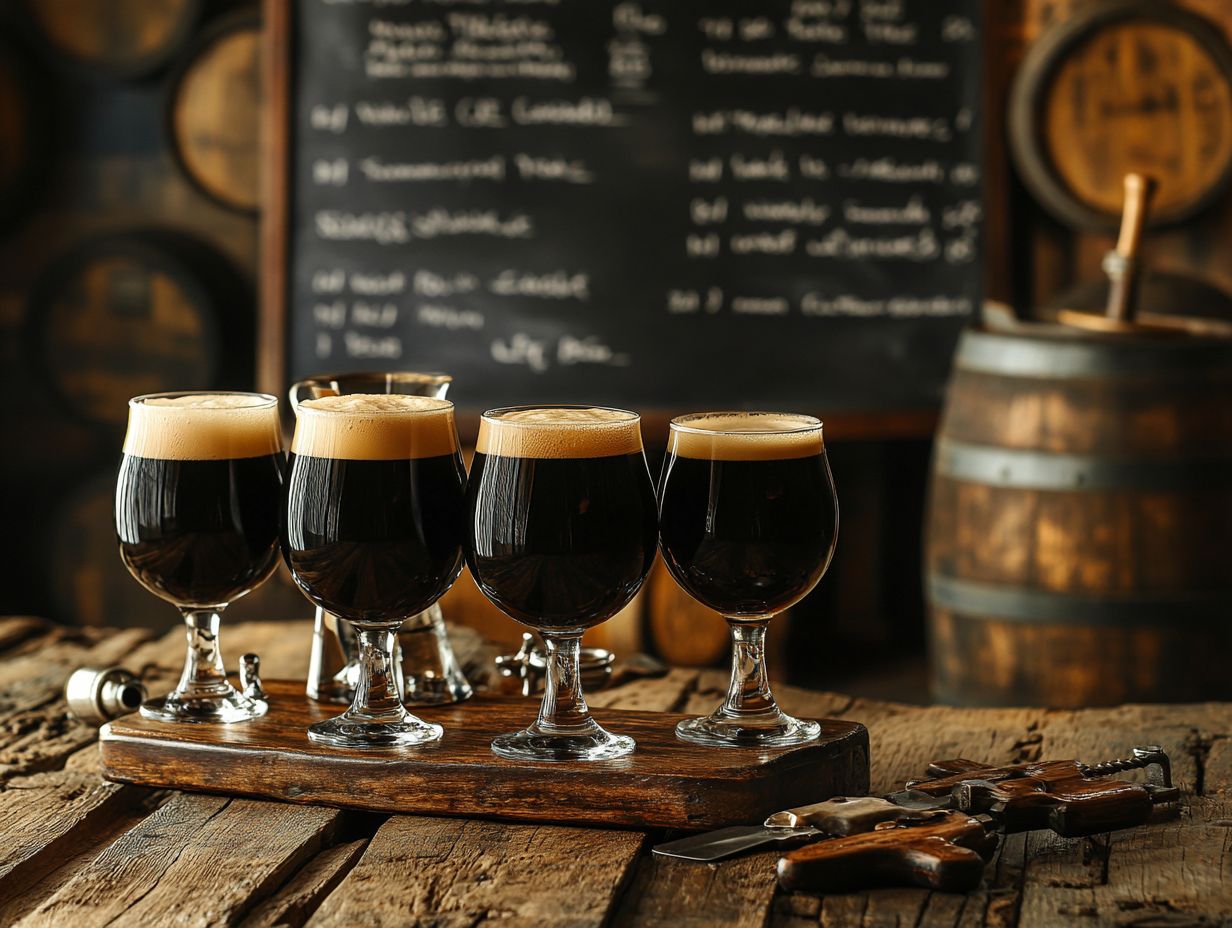
The rise of microbreweries has transformed the beer industry, offering a vibrant platform for small-scale brewers like you to craft unique stout variations that capture local flavors and ingredients. This movement has nurtured a tight community of brewers, thriving on collaboration and fueled by the passion of beer enthusiasts. Examples of this trend can be seen in places like Portland, Oregon, home to Hammer & Stitch and many other innovative breweries.
These establishments embrace experimental techniques and diverse ingredient sourcing. They prioritize sustainability and support local farmers. By incorporating indigenous grains, spices, and even local produce into your stout recipes, you can craft brews that tell your community’s rich story! This strong dedication attracts consumers who seek more than just a drink; they desire an experience that connects them to their community.
Microbreweries often host events and tastings, encouraging engagement and education about the art of brewing. In doing so, they establish themselves as social hubs for craft beer aficionados, inviting you to be part of a lively culture that celebrates creativity and connection.
3. The Growing Demand for Unique Flavors
The increasing demand for distinctive flavors in stout beer is transforming the brewing landscape, inviting you to explore a world where craft breweries are boldly experimenting with diverse ingredients and innovative brewing techniques. This creative exploration is tailored for adventurous palates, redefining what you might expect from traditional stouts. Whether it’s the smoky flavor of a dry stout or the indulgent taste of a pastry stout, the options are endless.
As your taste buds evolve, you’ll notice breweries infusing their stouts with unconventional elements like coffee, chocolate, and even fruity notes. This bold approach has given rise to exciting variations such as milk stouts and imperial stouts, inviting you to discover new dimensions of flavor.
In this dynamic brewing community, there’s a refreshing return to classic recipes, coupled with the incorporation of barrel-aging methods the practice of aging beer in wooden barrels to enhance its flavor and new hop varieties that enhance complexity. Breweries are captivating you with distinctive tasting experiences that challenge and expand your understanding of stout.
The Health Benefits of Stout Beer
Stout beer, renowned for its rich flavors and robust character, presents an array of health benefits that you may find intriguing. Packed with nutritional value and antioxidant properties, it makes for a favorable choice if you want to indulge in craft beer without guilt!
Enjoying a stout can be part of a balanced approach, allowing you to savor the complexities of this delightful beverage while remaining mindful of your well-being.
1. Nutritional Value
The nutritional value of stout beer is often underestimated. It holds essential vitamins and minerals that can genuinely enhance your overall health, offering a delightful blend of enjoyment and nourishment for discerning beer enthusiasts. Institutions like Diageo and Heineken have significantly contributed to understanding these benefits.
Rich in B vitamins especially B6, riboflavin, niacin, and folate stout beer can boost your metabolism and energy production. It also contains vital minerals such as magnesium, phosphorus, and potassium, crucial for maintaining essential bodily functions and supporting cardiovascular health.
Unlike many lighter alcoholic beverages, the deeper flavors and darker grains of stout provide a variety of antioxidants, known for their protective benefits against oxidative stress. This makes stout an enticing choice for those seeking not just a flavorful experience but also nutritional rewards that enhance their well-being.
Conclusion: Enjoy stout responsibly, as it can provide both taste and health benefits.
2. Antioxidant Properties
Stout beer is a treasure trove of antioxidants, which play a crucial role in fighting oxidative stress and promoting overall health. When enjoyed in moderation, it can be a delightful addition to a balanced diet.
These antioxidants primarily come from the dark malts used in brewing, enhancing the beer’s rich flavor profile while also delivering impressive health benefits. Exciting research shows that indulging in stout may lower the risk of certain chronic diseases by neutralizing harmful free radicals in your body.
Compounds like flavonoids are present as well, contributing to improved heart health by supporting blood circulation and potentially lowering blood pressure. Appreciating stout goes beyond its unique taste; it s also about the wellness benefits it offers. Whether you’re savoring a porter or an American stout, this makes it a compelling choice for anyone looking to enjoy their drink while being conscious of their health.
Conclusion: Stout s antioxidants provide valuable health benefits, making it a smart choice for health-conscious drinkers.
3. Heart Health Benefits
When you drink a sweet stout or a milk stout, you’re not just enjoying the taste; you’re also supporting your health in various ways. Moderate consumption of stout beer has been linked to heart health benefits. Studies suggest that the compounds found in dark ales may help reduce the risk of cardiovascular diseases.
Research reveals that the antioxidants, particularly polyphenols, present in stout beer, including different types like chocolate stout and oatmeal stout, can improve blood circulation and reduce inflammation critical factors for maintaining a healthy heart.
One study published in the Journal of Agricultural and Food Chemistry highlighted that these antioxidants could lower LDL cholesterol, often referred to as ‘bad’ cholesterol, while simultaneously boosting HDL cholesterol, known as ‘good’ cholesterol. Those who appreciate the brewing traditions behind these drinks can take heart in their positive health implications.
For those who savor the rich flavors of stout, this information provides a delightful perspective on how moderate indulgence may positively contribute to cardiovascular health. It makes stout not just an enjoyable choice but a potential ally in a heart-healthy lifestyle.
Conclusion: Enjoying stout in moderation can be a flavorful way to support your heart health.
4. Bone Health Benefits
Stout beer, such as a robust Baltic porter, may play a role in enhancing your bone health, thanks to its mineral content. This is particularly true for varieties that feature ingredients abundant in calcium and magnesium. You ll be amazed at how this flavorful drink can also support your bone health, reinforcing the notion that moderate beer consumption can come with positive health implications.
Beyond just calcium and magnesium, stout beer often contains other beneficial minerals like phosphorus and potassium. These minerals are crucial for maintaining your bone density and strength. For instance, phosphorus is essential for forming bones and teeth, while potassium helps balance mineral levels in your body, contributing to overall skeletal health. This makes beers such as dry stout (a type known for its dry finish) and imperial stout (a stronger version with higher alcohol content) not only flavorful but also beneficial for your health.
When you indulge in stout beer in moderation, you’re not just relishing its rich flavors; you could also be supporting your nutritional needs. This distinctive beverage exemplifies how some traditional drinks can serve a dual purpose, seamlessly blending enjoyment with health benefits.
Frequently Asked Questions
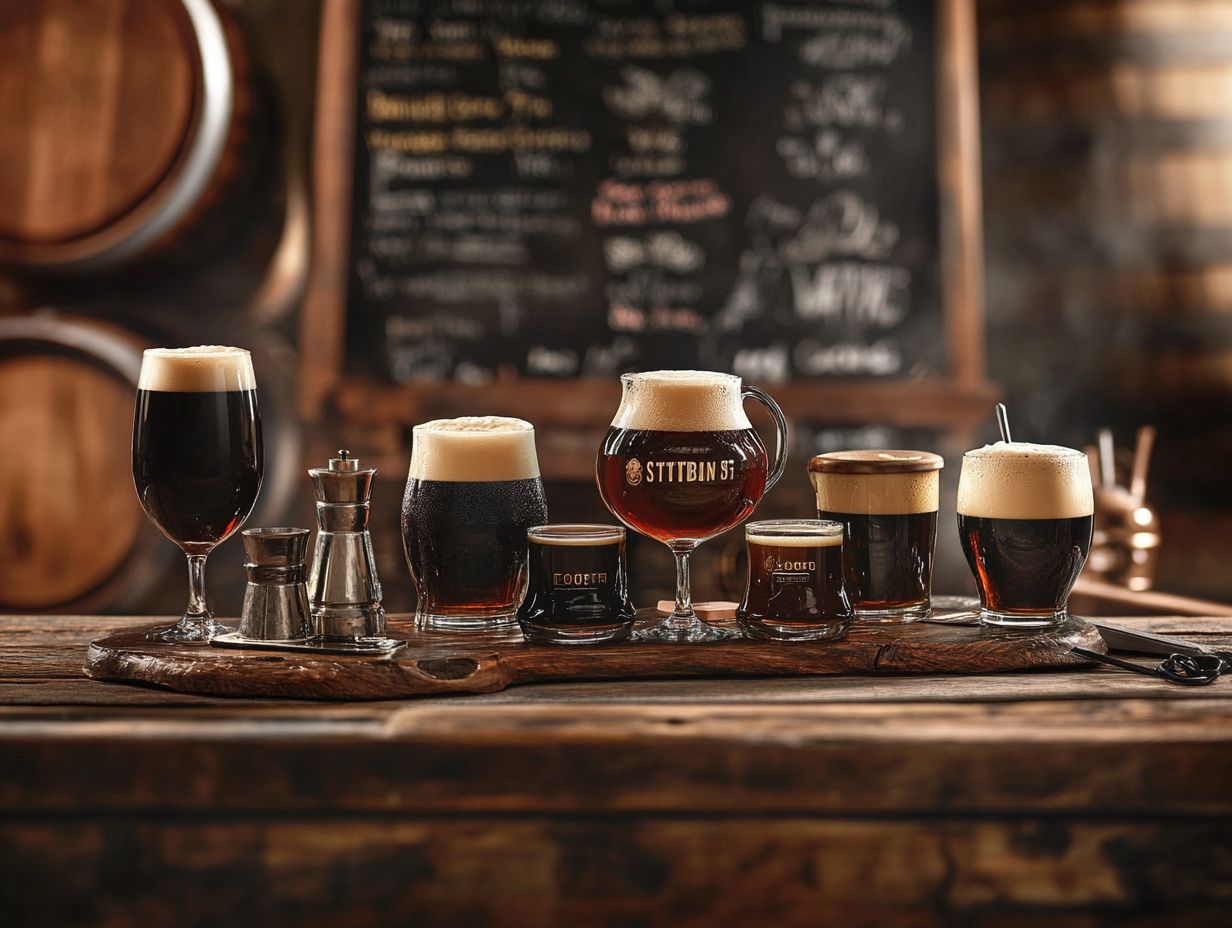
What is the history behind stout beers?
Stout beers originated in the 18th century in London, England. They were a stronger and more robust version of the popular porter style beers.
Why are stout beers dark in color?
Stout beers get their dark color from the use of roasted barley during the brewing process, which also adds a rich, roasted flavor to the beer.
Were stout beers always popular?
Stout beers were not always as popular as they are today. Initially considered a working-class drink, they were often referred to as “liquid bread” due to their high calorie and nutritional content. The brewing history of stout beers reveals their transformation from a niche drink to a global phenomenon.
How did stout beers gain popularity?
In the late 19th and early 20th centuries, stout beers became popular among Irish immigrants in the United States. Breweries like Anchor and New Albion played a significant role in this brewery revival, increasing their popularity and making them more widely available. Modern craft breweries have furthered this by including stouts in their beer varieties, contributing to the ongoing beer evolution.
Are all stout beers the same?
No, there are various types of stout beers, including dry stouts, imperial stouts, and milk stouts. Each type has its own unique characteristics and flavors. Other popular variants include pastry stout and pub porter, each offering a different tasting experience.
What is the significance of stout beers in Irish culture?
Stout beers, particularly Guinness, have become deeply ingrained in Irish culture and are often associated with St. Patrick’s Day celebrations. The Guinness brewery in Dublin is also a popular tourist attraction, and brewing innovations from Ireland have influenced stout beer recipes worldwide.

